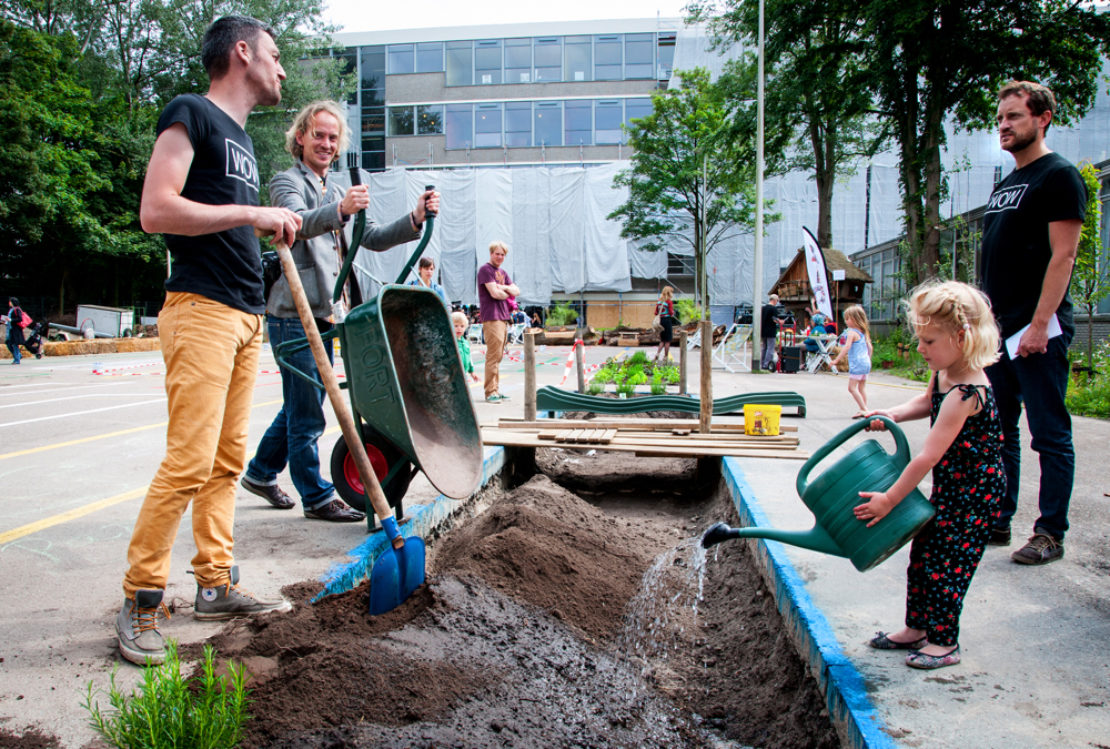In Amsterdam, heavy weather presents as many opportunities as it does problems

Amsterdam has long lead the rest of the world in urban water management. It's no surprise: with much of the Netherlands lying below sea level – mostly manmade areas reclaimed from lakes and the sea – the country has learned to design and invent itself out of trouble. In the Dutch capital, the lopsided terraced houses reflected in precariously high waters along the city's many picturesque canals tell us as much about the city's history of water management as does the complex of dykes, dams and floodgates around its periphery.
But while rising sea levels can be handled through macro-engineering efforts, minimising the damage from extreme weather events is starting to require a much more hands-on approach from Amsterdammers.
Public perception of flood management in Amsterdam has steadily changed. What was once considered an external threat to be dealt with by crisis response teams is now viewed as a design challenge by the city's local government. And increasingly, DIY enthusiasts are leading an emerging trend for weatherproofing one's own home.
It's all thanks to Amsterdam Rainproof, a collaborative project from Waternet, the city's water company, and the regional water authority. They're promoting greater individual responsibility for collecting, storing and putting to efficient use excess rain water.
While extreme weather devastated parts of northern England at the end of last year, the Dutch example of continually and proactively supporting innovation in water management seems a necessary cue to follow
Amsterdam Rainproof was created to encourage both town planners and individual citizens to promote rain-saving initiatives. It provides a platform through which users can share their experiences from across the city, as well as a toolkit and neighbourhood factsheet for those implementing largescale designs. These include details of the streets, alleyways and buildings prone to flooding, and a geotagged system of water-related complaints received from local residents.
"Everyone was looking to Waternet to provide answers to the impacts of extreme weather," says programme manager Daniel Goedbloed. "It was Waternet's role therefore to communicate with everyone living in the city – everybody working in the city – that it is our shared responsibility to retain rainwater, particularly in spots that are prone to flooding."
Initiatives shared on the site's interactive map include Rooftop Revolution, a crowdfunding effort to get more people planting above their homes.
"People don't want to look on to an asphalt roof," Goedbloed explains, referencing another means of engaging people in the effort to stave off flooding: aesthetics. "So the idea came about for a crowdfunding model to support the creation of rooftop gardens. You get 75 households to donate €100 towards making the roof outside of their window more attractive; you ask the tenant of the property to invest in a system that would lead to cheaper energy prices; and voilà: you have enough money to build a rooftop garden."
Sign up to our newsletter
Goedbloed's favourite project since Rainproof launched is an alternative rooftop garden, installed in 2013. The design is adapted from the polder system used for centuries in the Netherlands to regulate land water levels across its western coastline. A dyke is built around the roof and the garden raised 8cm above it. Cigarette-type filters are then installed to percolate water that gathers in the surrounding tributaries. It's a system that maximises the amount of water held on the roof, while providing ample storage to last through the drier months of summer.
Other small but important solutions are being rolled out across the city. Rooftop tanks are used to water the planted facades of a growing number of houses. Exaggeratedly convex road systems are capable of storing far greater volumes of water at the sides of the road than conventional designs, preventing water from spilling over on to the curb.
Goedbloed and his team are also working actively with homeware stores across the city to promote the sale and use of waterproofing products, such as rain-saving barrels and rain-retentive ponds.
It all plays into the organisation's philosophy, and one adopted by the city more broadly: 'Live with water, don't fight it'. While extreme weather devastated parts of northern England at the end of last year, the Dutch example of continually and proactively supporting innovation in water management seems a necessary cue to follow.
Most read
Fiction: Divided we stand, by Tim Maughan How Scotland is tackling the democratic deficit The Long + Short has ceased publishingOutside of direct flood measurements, Amsterdam is a city that embraces all aspects of life surrounded by water. In summer, thousands of people pile into Hannekes Boom, a bar built out of second-hand materials and sitting on a jetty to the northeast of the city, where people in boats can pull in to refuel over a drink with friends.

And it's not just grassroots movements embracing the tributaries. For better or worse, the rapidly developing district of Houthavens to the northwest of the city will soon to be home to Amsterdam's most expensive apartment complex, the Pontsteiger, built entirely on water with a special gateway for luxury yachts. A stone's throw away, the more moderate REM Eiland restaurant continues to service a devout fanbase at its residence on the third floor of a disused oil rig.
Rainproof hopes that its optimism will be infectious, and that others will subscribe to the idea that floods present as many opportunities as they do problems. Only by believing that, Goedbloed says, can the city hope to find solutions to problems before they become hazardous.
"The point where the water actually hits the roof or hits the building is the point at which you can actually begin to store and retain it. We all need to start developing ways of harnessing water at that point, before it risks overloading the system and causing widespread damage through flooding."